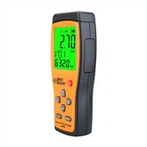Differences between anemometers
On site anemometer measurement is mainly divided into three types based on principle: pressure difference type, impeller type, and hot ball type
The differential pressure method is a classic method for measuring flow velocity in fluid mechanics, which mainly relies on Pitot tubes and differential pressure gauges to measure the dynamic pressure, and then calculates the flow velocity based on the Bernoulli equation. The advantages of this method are low detection limit and high sensitivity, but the requirement for uniformity of the convection field is high. When measuring in the environment, it is easy to be inaccurate due to uneven flow field. Therefore, the pressure difference method is mainly used to measure wind speed in ducts.
The main principle of the hot ball type is that the probe is set at a constant temperature, and air passing through the probe will carry away heat. At this point, the probe will be heated to the set temperature, and during this process, electrical signals will be collected by the instrument and converted into wind speed based on this. The advantages of this method are high sensitivity, large range, and adaptability to environmental measurement. The disadvantage is that the platinum wire connecting the hot ball in the probe is relatively fragile, and if not careful during use, it can easily cause damage to the probe and cannot be repaired. At present, the domestic hot ball anemometer is still an old-fashioned anemometer, and the Air Conditioning Institute of the Construction Research Institute has a more advanced alternative technology, replacing the hot ball with a ceramic hot column, which has much better strength than the hot ball.
The impeller type mainly relies on the wind to rotate the impeller, generating electromagnetic signals for measurement. The advantage of this method is that the instrument is relatively durable and commonly used for long-term measurement. The three cup anemometer used in meteorological observation also shares the same principle, but the disadvantage is that the sensitivity is slightly poor.
Measurement of airflow velocity in pipelines using an anemometer
Practice has proven that the 16mm probe of the anemometer is the most widely used. Its size ensures good permeability and can withstand flow rates up to 60m/s. The measurement of airflow velocity in pipelines is one of the feasible measurement methods, and the indirect measurement regulation (grid measurement method) is applicable to air measurement.
Square cross-section gate, measuring ordinary specifications
Circular cross-section gate, measuring the specifications of the centroid axis
Circular cross-section gate, measuring range linear specifications
Measurement of Anemometers in Exhaust Gas Extraction
The ventilation port will greatly change the relatively balanced distribution of airflow in the pipeline: a high-speed zone will be generated on the surface of the free ventilation port, while the other parts will be low-speed zones, and vortices will be generated on the grid. According to different design methods of the grid, the airflow cross-section is relatively stable at a certain distance (about 20cm) in front of the grid. In this case, measurements are usually made using the caliber wheel of a high wind speed instrument. Because larger apertures can average uneven flow rates and calculate their average values over a larger range.






